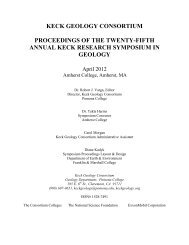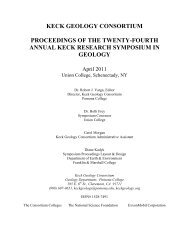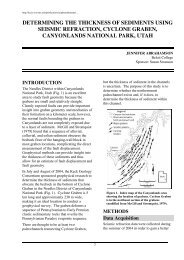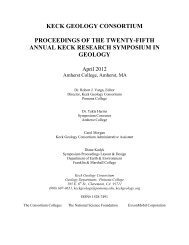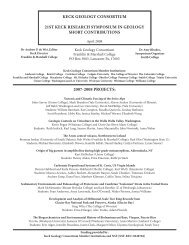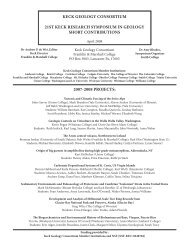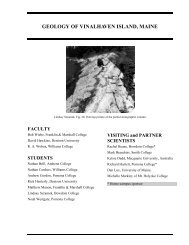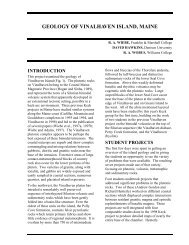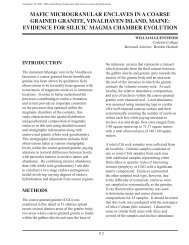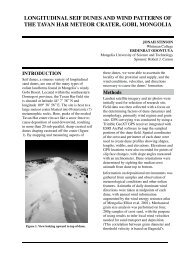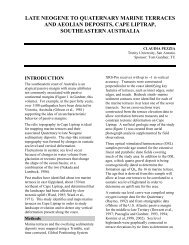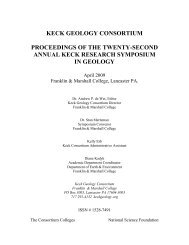CORRELATION OF TREE RING ANALYSIS AND CLIMATOGICAL ...
CORRELATION OF TREE RING ANALYSIS AND CLIMATOGICAL ...
CORRELATION OF TREE RING ANALYSIS AND CLIMATOGICAL ...
Create successful ePaper yourself
Turn your PDF publications into a flip-book with our unique Google optimized e-Paper software.
KECK GEOLOGY CONSORTIUM<br />
PROCEEDINGS <strong>OF</strong> THE TWENTY-FOURTH<br />
ANNUAL KECK RESEARCH SYMPOSIUM IN<br />
GEOLOGY<br />
April 2011<br />
Union College, Schenectady, NY<br />
Dr. Robert J. Varga, Editor<br />
Director, Keck Geology Consortium<br />
Pomona College<br />
Dr. Holli Frey<br />
Symposium Convenor<br />
Union College<br />
Carol Morgan<br />
Keck Geology Consortium Administrative Assistant<br />
Diane Kadyk<br />
Symposium Proceedings Layout & Design<br />
Department of Earth & Environment<br />
Franklin & Marshall College<br />
Keck Geology Consortium<br />
Geology Department, Pomona College<br />
185 E. 6 th St., Claremont, CA 91711<br />
(909) 607-0651, keckgeology@pomona.edu, keckgeology.org<br />
ISSN# 1528-7491<br />
The Consortium Colleges The National Science Foundation ExxonMobil Corporation
KECK GEOLOGY CONSORTIUM<br />
PROCEEDINGS <strong>OF</strong> THE TWENTY-FOURTH ANNUAL KECK<br />
RESEARCH SYMPOSIUM IN GEOLOGY<br />
ISSN# 1528-7491<br />
April 2011<br />
Robert J. Varga<br />
Editor and Keck Director<br />
Pomona College<br />
Keck Geology Consortium<br />
Pomona College<br />
185 E 6 th St., Claremont, CA<br />
91711<br />
Diane Kadyk<br />
Proceedings Layout & Design<br />
Franklin & Marshall College<br />
Keck Geology Consortium Member Institutions:<br />
Amherst College, Beloit College, Carleton College, Colgate University, The College of Wooster,<br />
The Colorado College, Franklin & Marshall College, Macalester College, Mt Holyoke College,<br />
Oberlin College, Pomona College, Smith College, Trinity University, Union College,<br />
Washington & Lee University, Wesleyan University, Whitman College, Williams College<br />
2010-2011 PROJECTS<br />
FORMATION <strong>OF</strong> BASEMENT-INVOLVED FOREL<strong>AND</strong> ARCHES: INTEGRATED STRUCTURAL <strong>AND</strong><br />
SEISMOLOGICAL RESEARCH IN THE BIGHORN MOUNTAINS, WYOMING<br />
Faculty: CHRISTINE SIDDOWAY, MEGAN <strong>AND</strong>ERSON, Colorado College, ERIC ERSLEV, University of<br />
Wyoming<br />
Students: MOLLY CHAMBERLIN, Texas A&M University, ELIZABETH DALLEY, Oberlin College, JOHN<br />
SPENCE HORNBUCKLE III, Washington and Lee University, BRYAN MCATEE, Lafayette College, DAVID<br />
OAKLEY, Williams College, DREW C. THAYER, Colorado College, CHAD TREXLER, Whitman College, TRIANA<br />
N. UFRET, University of Puerto Rico, BRENNAN YOUNG, Utah State University.<br />
EXPLO<strong>RING</strong> THE PROTEROZOIC BIG SKY OROGENY IN SOUTHWEST MONTANA<br />
Faculty: TEKLA A. HARMS, JOHN T. CHENEY, Amherst College, JOHN BRADY, Smith College<br />
Students: JESSE DAVENPORT, College of Wooster, KRISTINA DOYLE, Amherst College, B. PARKER HAYNES,<br />
University of North Carolina - Chapel Hill, DANIELLE LERNER, Mount Holyoke College, CALEB O. LUCY,<br />
Williams College, ALIANORA WALKER, Smith College.<br />
INTERDISCIPLINARY STUDIES IN THE CRITICAL ZONE, BOULDER CREEK CATCHMENT,<br />
FRONT RANGE, COLORADO<br />
Faculty: DAVID P. DETHIER, Williams College, WILL OUIMET. University of Connecticut<br />
Students: ERIN CAMP, Amherst College, EVAN N. DETHIER, Williams College, HAYLEY CORSON-RIKERT,<br />
Wesleyan University, KEITH M. KANTACK, Williams College, ELLEN M. MALEY, Smith College, JAMES A.<br />
MCCARTHY, Williams College, COREY SHIRCLIFF, Beloit College, KATHLEEN WARRELL, Georgia Tech<br />
University, CIANNA E. WYSHNYSZKY, Amherst College.<br />
SEDIMENT DYNAMICS & ENVIRONMENTS IN THE LOWER CONNECTICUT RIVER<br />
Faculty: SUZANNE O’CONNELL, Wesleyan University<br />
Students: LYNN M. GEIGER, Wellesley College, KARA JACOBACCI, University of Massachusetts (Amherst),<br />
GABRIEL ROMERO, Pomona College.<br />
GEOMORPHIC <strong>AND</strong> PALEOENVIRONMENTAL CHANGE IN GLACIER NATIONAL PARK,<br />
MONTANA, U.S.A.<br />
Faculty: KELLY MACGREGOR, Macalester College, CATHERINE RIIHIMAKI, Drew University, AMY MYRBO,<br />
LacCore Lab, University of Minnesota, KRISTINA BRADY, LacCore Lab, University of Minnesota
Students: HANNAH BOURNE, Wesleyan University, JONATHAN GRIFFITH, Union College, JACQUELINE<br />
KUTVIRT, Macalester College, EMMA LOCATELLI, Macalester College, SARAH MATTESON, Bryn Mawr<br />
College, PERRY ODDO, Franklin and Marshall College, CLARK BRUNSON SIMCOE, Washington and Lee<br />
University.<br />
GEOLOGIC, GEOMORPHIC, <strong>AND</strong> ENVIRONMENTAL CHANGE AT THE NORTHERN<br />
TERMINATION <strong>OF</strong> THE LAKE HÖVSGÖL RIFT, MONGOLIA<br />
Faculty: KARL W. WEGMANN, North Carolina State University, TSALMAN AMGAA, Mongolian University of<br />
Science and Technology, KURT L. FRANKEL, Georgia Institute of Technology, <strong>AND</strong>REW P. deWET, Franklin &<br />
Marshall College, AMGALAN BAYASAGALN, Mongolian University of Science and Technology.<br />
Students: BRIANA BERKOWITZ, Beloit College, DAENA CHARLES, Union College, MELLISSA CROSS, Colgate<br />
University, JOHN MICHAELS, North Carolina State University, ERDENEBAYAR TSAGAANNARAN, Mongolian<br />
University of Science and Technology, BATTOGTOH DAMDINSUREN, Mongolian University of Science and<br />
Technology, DANIEL ROTHBERG, Colorado College, ESUGEI GANBOLD, ARANZAL ERDENE, Mongolian<br />
University of Science and Technology, AFSHAN SHAIKH, Georgia Institute of Technology, KRISTIN TADDEI,<br />
Franklin and Marshall College, GABRIELLE VANCE, Whitman College, <strong>AND</strong>REW ZUZA, Cornell University.<br />
LATE PLEISTOCENE EDIFICE FAILURE <strong>AND</strong> SECTOR COLLAPSE <strong>OF</strong> VOLCÁN BARÚ, PANAMA<br />
Faculty: THOMAS GARDNER, Trinity University, KRISTIN MORELL, Penn State University<br />
Students: SHANNON BRADY, Union College. LOGAN SCHUMACHER, Pomona College, HANNAH ZELLNER,<br />
Trinity University.<br />
KECK SIERRA: MAGMA-WALLROCK INTERACTIONS IN THE SEQUOIA REGION<br />
Faculty: JADE STAR LACKEY, Pomona College, STACI L. LOEWY, California State University-Bakersfield<br />
Students: MARY BADAME, Oberlin College, MEGAN D’ERRICO, Trinity University, STANLEY HENSLEY,<br />
California State University, Bakersfield, JULIA HOLL<strong>AND</strong>, Trinity University, JESSLYN STARNES, Denison<br />
University, JULIANNE M. WALLAN, Colgate University.<br />
EOCENE TECTONIC EVOLUTION <strong>OF</strong> THE TETONS-ABSAROKA RANGES, WYOMING<br />
Faculty: JOHN CRADDOCK, Macalester College, DAVE MALONE, Illinois State University<br />
Students: JESSE GEARY, Macalester College, KATHERINE KRAVITZ, Smith College, RAY MCGAUGHEY,<br />
Carleton College.<br />
Funding Provided by:<br />
Keck Geology Consortium Member Institutions<br />
The National Science Foundation Grant NSF-REU 1005122<br />
ExxonMobil Corporation
Keck Geology Consortium: Projects 2010-2011<br />
Short Contributions— Hövsgöl Rift, Mongolia<br />
GEOLOGIC, GEOMORPHIC, <strong>AND</strong> ENVIRONMENTAL CHANGE AT THE NORTHERN<br />
TERMINATION <strong>OF</strong> THE LAKE HÖVSGÖL RIFT, MONGOLIA<br />
Project Faculty: KARL W. WEGMANN: North Carolina State University, TSALMAN AMGAA: Mongolian<br />
University of Science and Technology, KURT L. FRANKEL: Georgia Institute of Technology, <strong>AND</strong>REW P.<br />
deWET: Franklin & Marshall College, AMGALAN BAYASAGALN: Mongolian University of Science and<br />
Technology<br />
MAPPING <strong>AND</strong> RELATIVE AGE DATING <strong>OF</strong> MORAINES IN THE HOROO GOL VALLEY,<br />
HÖVSGÖL RIFT, MONGOLIA<br />
BRIANA BERKOWITZ, Beloit College<br />
Research Advisor: Susan Swanson<br />
PALEOLIMNOLOGY <strong>AND</strong> PALEOCLIMATE ENVIRONMENT REVEALED THROUGH HOLOCENE<br />
LAKE SHORE SEDIMENTS FROM HÖVSGÖL, MONGOLIA<br />
DAENA CHARLES, Union College<br />
Research Advisor: Donald Rodbell<br />
A MULTI-PROXY STUDY <strong>OF</strong> HOLOCENE PALEOCLIMATE <strong>AND</strong> DEPOSITIONAL ENVIRONMENT,<br />
HÖVSGÖL, MONGOLIA<br />
MELLISSA CROSS, Colgate University<br />
Research Advisor: Bruce Selleck<br />
<strong>CORRELATION</strong> <strong>OF</strong> <strong>TREE</strong> <strong>RING</strong> <strong>ANALYSIS</strong> <strong>AND</strong> <strong>CLIMATOGICAL</strong> RECORDS IN THE LAKE<br />
HÖVSGÖL REGION <strong>OF</strong> MONGOLIA<br />
JOHN MICHAELS, North Carolina State University<br />
ERDENEBAYAR TSAGAANNARAN, Mongolian University of Science and Technology<br />
BATTOGTOH DAMDINSUREN, Mongolian University of Science and Technology<br />
Research Advisor: Karl Wegmann<br />
LATE PLEISTOCENE GLACIATION <strong>AND</strong> TECTONICS AT LAKE HÖVSGÖL<br />
DANIEL ROTHBERG, Colorado College<br />
Mongolian Participants: Esugei Ganbold, Aranzal Erdene<br />
Research Advisor: Eric Leonard<br />
TIMING <strong>AND</strong> EXTENT <strong>OF</strong> LATE QUATERNARY GLACIATIONS NEAR LAKE HÖVSGÖL,<br />
MONGOLIA: IMPLICATIONS FOR CLIMATE CHANGE IN CENTRAL ASIA<br />
AFSHAN SHAIKH, Georgia Institute of Technology<br />
Research Advisor: Kurt L. Frankel<br />
THE PALEOSEDIMENTARY ENVIRONMENT <strong>AND</strong> PALEOCLIMATIC CONDITIONS REVEALED BY<br />
STRATIGRAPHY IN HOLOCENE BOG <strong>AND</strong> TERRACE SEDIMENTS, NORTHWEST <strong>OF</strong> LAKE<br />
HÖVSGÖL, MONGOLIA<br />
KRISTIN TADDEI, Franklin and Marshall College<br />
Research Advisor: Dr. Andy deWet<br />
PLEISTOCENE GLACIATION <strong>OF</strong> THE EASTERN SAYAN RANGE, NORTHERN MONGOLIA<br />
GABRIELLE VANCE, Whitman College<br />
ESUGEI GANBOLD, Mongolia University of Science and Technology<br />
Research Advisors: Bob Carson and Nick Bader
LATE-CENOZOIC VOLCANISM IN THE HÖVSGÖL RIFT BASIN: SOURCE, GENESIS, <strong>AND</strong><br />
EVOLUTION <strong>OF</strong> INTRAPLATE VOLCANISM IN MONGOLIA<br />
<strong>AND</strong>REW ZUZA, Cornell University<br />
ARANZAL BAT-ERDENE, Mongolian University of Science and Technology<br />
Research Advisor: Christopher Andronicos<br />
Keck Geology Consortium<br />
Pomona College<br />
185 E. 6 th St., Claremont, CA 91711<br />
Keckgeology.org
24th Annual Keck Symposium: 2011 Union College, Schenectady, NY<br />
<strong>CORRELATION</strong> <strong>OF</strong> <strong>TREE</strong> <strong>RING</strong> <strong>ANALYSIS</strong> <strong>AND</strong><br />
<strong>CLIMATOGICAL</strong> RECORDS IN THE LAKE HÖVSGÖL REGION<br />
<strong>OF</strong> MONGOLIA<br />
JOHN MICHAELS, North Carolina State University<br />
ERDENEBAYAR TSAGAANNARAN, Mongolian University of Science and Technology<br />
BATTOGTOH DAMDINSUREN, Mongolian University of Science and Technology<br />
Research Advisor: Karl Wegmann<br />
INTRODUCTION<br />
The Lake Hövsgöl region receives most of its annual<br />
precipitation during the mild summer months of July<br />
and August, while winter is harsh and typically very<br />
cold and dry. Climatic data sets from 3 meteorological<br />
monitoring stations (MMS) near Lake Hövsgöl<br />
reveal a 1°C increase in mean annual temperature<br />
over the past 20 years. The findings of Batima et<br />
al. (2005), with similar data, agree that the mean air<br />
temperature has increased by 1.66°C for the last 70<br />
years, with distinct warming from the beginning of<br />
the 1970s increasing toward the end of the 1980s<br />
and 1990s. This indicates that both the summers and<br />
winters of Lake Hövsgöl are warming. Do the nomadic<br />
and semi-nomadic herders of Lake Hövsgöl<br />
(or for that matter all Mongolians) have reason to be<br />
concerned about a 1°C increase in temperature over<br />
the past 20 years? What is the impact of this temperature<br />
change on the Mongolian ecosystem? Changes<br />
in weather patterns may disrupt the growth of grasses<br />
which are key to the survival of foraging livestock<br />
upon which the majority of the Mongolian populous<br />
depends. Nearly 50 percent of Mongolia’s population<br />
is reliant on animal husbandry with an additional 35%<br />
of the population dependent upon agricultural gross<br />
production, which accounts for 30% of Mongolia’s<br />
export. Climatic changes may adversely impact pasture<br />
availability, threatening forage yield, endangering<br />
livestock productivity, and ultimately adversely<br />
impacting the food production capacity of local and<br />
national food producers.<br />
The goal of this project is to characterize the variability<br />
of precipitation and temperature change through<br />
the construction of native tree ring chronologies and<br />
ring-width indices spanning several hundred years for<br />
the northern Lake Hövsgöl region and perform stable<br />
isotopic analysis of extracted alpha-cellulose in an effort<br />
to validate the instrumented climatic observations<br />
over longer time periods. Analysis of the ratios of<br />
stable isotopes (O, H) in cellulose can be used as “palaeothermometers”<br />
to help reconstruct a climatologic<br />
record (Wilson and Grinsted, 1977). For this project,<br />
analysis was performed on a single wood component,<br />
cellulose, in order to minimize the variability of the<br />
ratio of wood constituents like lignin-to-cellulose as<br />
noted in (Wilson and Grinsted, 1977).<br />
Figure 1. Study areas and meteorological monitoring stations<br />
(MMS) near Lake Hövsgöl<br />
249
24th Annual Keck Symposium: 2011 Union College, Schenectady, NY<br />
STUDY SITES<br />
The Hövsgöl basin lies at the southern limit of the<br />
continuous Siberian boreal (taiga) forest. At the<br />
latitude of northern Lake Hövsgöl, forest stands<br />
are naturally composed almost entirely of Siberian<br />
larch (Larix siberica). The tree core samples for this<br />
study were gathered from several sites that lie along<br />
the northern shores of Lake Hövsgöl in the Horoo<br />
Gol valley (51.570° N; 100.462°E). Siberian larch<br />
chosen for this study are growing on south facing<br />
slopes, widely separated from other trees in the stand,<br />
and have large diameters (> 2 m) and heights (>18<br />
m). Southern slopes were chosen because they are<br />
moisture-limited, making the stable-isotope analysis<br />
more feasible. Additionally, the selected trees were<br />
screened to avoid those with signs of burn scars,<br />
insect infestation or outward signs of heart-rot (to<br />
which L. Siberica is prone) and those with obvious<br />
anthropogenic influence. The slope aspect of the<br />
selected trees ranged from 0 to 31° (mean = 8°) and<br />
are covered with thin mantles and solifluction debris<br />
composed of granitic and balsatic rocks. The position<br />
of the tree line and the diversity and distribution<br />
of species in northern Mongolia are climatically<br />
controlled by humidity (total effective moisture) and<br />
temperature gradients (Jacoby et al., 2003).<br />
METHODS <strong>AND</strong> MATERIALS<br />
This study was conducted in two phases, tree ring<br />
analysis to construct chronologies and ring-width<br />
indices and the stable-isotope analysis of the core<br />
samples.<br />
Tree Ring Analysis<br />
During the months of July and August 2010, a total<br />
of thirty-one tree cores were taken from twenty-nine<br />
L. Siberica using a 5 mm increment borer at breastheight<br />
(Table 1). For those trees with non-zero slope<br />
aspects, the cores were taken parallel to the slope contour<br />
thereby avoiding reaction wood (Speer, 2010).<br />
Two cores were taken from selected trees in order to<br />
obtain a full diameter core section. The cores were<br />
stored in plastic straws to avoid damage in transit and<br />
storage prior to preparation.<br />
Cores were prepared using Speer’s methodology<br />
(Speer, 2010). The cores were removed from the<br />
straws and placed in wooden sample holders; some<br />
samples showed evidence of mold. The cores were<br />
glued into the concave slot of the sample holders<br />
using wood glue and allowed to dry for at least 24<br />
hours. The protruding upper half of the core was then<br />
removed down to the level of the sample holder by<br />
both belt and hand sanding with progressively finer<br />
grit sandpaper until a smooth surface was obtained.<br />
The orientation (bark-ring) of the sample was denoted<br />
on the sample holder for reference.<br />
.<br />
Table 1. Trees cored by location, elevation, circumference,<br />
slope, aspect, species, height and age<br />
The prepared samples were then visually analyzed<br />
under a binocular microscope at 30x magnification<br />
and the width of individual rings measured and<br />
recorded with a Velamex Rapid Advance Unislide<br />
linear encoder that interfaces between the microscope<br />
and a PC using the ring counting procedure outlined<br />
by Speer (Speer, 2010). This process starts by assigning<br />
the year of the core acquisition to the bark end of<br />
the sample and then counts rings backwards in time<br />
to the sample pith. Total ring widths (including early<br />
and late wood) were measured to within 0.01 mm<br />
using the MeasureJ2X software package interfaced to<br />
the Velamax encoder. The ring width was exported<br />
from MeasureJ2X into a text file per core sample.<br />
Text files were manually edited to correct data format<br />
problems. These files were then imported into the<br />
250
24th Annual Keck Symposium: 2011 Union College, Schenectady, NY<br />
TSAPWin software package (Rinntech GmbH, 2011)<br />
for cross-dating of time series. This step is critical to<br />
eliminate false rings, allow for insertion of missing<br />
rings and determine correlation between sites.<br />
Figure 2. A. Field methods B. alpha cellulose extraction<br />
lab methods<br />
Stable Isotope Analysis of Alpha Cellulose<br />
Because of reaction tissues and growth disturbances,<br />
most of the trees sampled were not dateable by<br />
dendrochronology. These tissues and disturbances<br />
disrupt the expected environmental signal of wide and<br />
narrow rings that enable cross-dating. Of the dated<br />
trees, three trees were selected for the hydrogen and<br />
oxygen isotopic analysis, however due to time limitations,<br />
only one tree was used. Selection criteria was<br />
based on three criteria used by (Loader et al., 2007):<br />
wood quality based on the absence of reaction tissue<br />
or rot, chronology (no partial/false rings) and age (to<br />
avoid potential isotopic ‘juvenile’ effects, samples<br />
chosen were greater than 150 years old). Alphacellulose<br />
was extracted and purified from the wood<br />
samples using a slightly modified Brendel method (;<br />
Fig. 3; Brendel et al., 2000) and placed in a desiccator<br />
filled with anhydrous silica gel prior to isotopic<br />
analysis. Oxygen and Hydrogen isotopes from the<br />
extracted alpha-cellulose were measured on an isotope<br />
ratio mass spectrometry (IRMS) in the North<br />
Carolina State University Stable Isotope Laboratory.<br />
At the time of writing, these analyses were ongoing.<br />
RESULTS <strong>AND</strong> DISCUSSION<br />
Although the results of the isotope analysis are not<br />
yet complete, the project intends to perform correlation<br />
analysis between dendroclimatic and stable<br />
isotope d 18 O data with the data sets obtained from<br />
251<br />
Figure 3. The modified protocol for purification of alpha<br />
cellulose from Micro-samples of tree cell wall material<br />
using acetic acid: nitric acid for simultaneous delignification<br />
and removal of non-cellulose polysaccharides, after<br />
Brendel et al., 2000.<br />
3 meteorological monitoring stations (MMS) around<br />
Lake Hövsgöl. Climatic data sets were obtained from<br />
Hotgol at the south end of lake, Hanh at the northern<br />
end of lake, and Renchinlkhumbe to the west in the<br />
Darhad depression. The mean annual, summer and<br />
winter temperature was plotted. A 0.05°C per year<br />
increase in temperature for the 3 stations equaling<br />
a 1°C increase in the past 20 years is observed as<br />
shown in Figure 5. Batima et al. (2005), using shorter<br />
temperature records from these three stations came to
24th Annual Keck Symposium: 2011 Union College, Schenectady, NY<br />
Figure 4. Recorded Temperature and precipitation as a function of time, 1960-2010 as reported from 3 meteorological<br />
monitoring stations (MMS) A. Hotogol B. Renchinlkhumbe C. Hanh. D. Recorded of precipitation amounts from Hotgol,<br />
Renchinlkhumbe, and Hanh.<br />
similar findings that the mean annual air temperature<br />
has increased by 1.66 °C for the last 70 years, with<br />
distinct warming from the beginning of the 1970s increasing<br />
toward the end of the 1980s and 1990s. The<br />
warming has been most pronounced and evident by a<br />
mean winter (October – March) temperature increase<br />
of 3.6 °C. Annual precipitation has increased by 1 to<br />
3.5 mm/yr as recorded by the three meteorological<br />
stations, as might be expected for a warming atmosphere.<br />
CONCLUSION<br />
Further discussion of the results and the conclusions<br />
based upon them are pending completion of the ongoing<br />
stable isotope analysis of the extracted alphacellulose.<br />
However, from the available recorded<br />
climatic data observations, it is evident that the mean<br />
annual temperature and the annual precipitation are<br />
both increasing. Because of the agrarian-basis of<br />
much of the Mongolian economy, changes to the<br />
climate, which potentially affect the growth of both<br />
fodder and forage are likely to have a bigger impact<br />
than they would on a more industrial-based economy.<br />
It might seem counter-intuitive that an increase in<br />
precipitation and temperature would have a negative<br />
impact on the continental climate of Mongolia,<br />
but historic flooding in 2009 which devastated even<br />
populated areas like Ulaanbaatar illustrates that such<br />
changes often result in negative outcomes.<br />
ACKNOWLEDGEMENTS<br />
I would like to thank RINNTECH for making their<br />
TSAPWin software available to me at a reduced cost.<br />
252
24th Annual Keck Symposium: 2011 Union College, Schenectady, NY<br />
I would also like to thank Battogtoh Damdinsuren,<br />
“Togii”, for making the Mongolian field trip much<br />
easier, more productive and culturally enlightening<br />
by lowering the language barrier between myself and<br />
the Mongolian team members and providing translation<br />
assistance. I’d also like to acknowledge Dr. Karl<br />
Wegmann’s contributions to this project, not the least<br />
of which was his patience and invaluable guidance in<br />
the laboratory work.<br />
REFERENCES<br />
Batima, P., Natsagdorj, L., Gombluudev, P., and<br />
Erdenetsetseg, B., 2005, Observed climate<br />
change in Mongolia: Assessments of Impacts<br />
and Adaptations to Climate Change Working<br />
Paper Number 12, p. 1–26.<br />
Brendel, O., Iannetta, P.P.M., and Stewart, D., 2000, A<br />
Rapid and Simple Method to Isolate Pure Alpha-<br />
Cellulose: Phytochemical Analysis, 11, p. 7-10.<br />
D’Arrigo, R., Jacoby, G., et al., 2000, Mongolian treerings,<br />
temperature sensitivity and reconstructions<br />
of Northern Hemisphere temperature: The<br />
Holocene, v. 10, no. 6, p. 669-672.<br />
Jacoby, G., Pederson, N., et al., 2003, Temperature<br />
and precipitation in Mongolia based on dendroclimatic<br />
investigations: Chinese Science Bulletin,<br />
v. 48, no. 14, p. 1474-1479.<br />
Loader NJ, McCarroll D, Gagen M, Robertson I and<br />
Jalkanen R (2007) Extracting climatic information<br />
from stable isotopes in tree rings. In: Dawson<br />
T, Siegwolf R (eds) Isotopes as Indicators of<br />
Environmental Change. Elsevier, 23–44.<br />
Loader, N. J., Helle, G., et al., 2010, Twentiethcentury<br />
summer temperature variability in the<br />
southern Altai Mountains: A carbon and oxygen<br />
isotope study of tree-rings: The Holocene, v. 20,<br />
no. 7, p, 1149-1156.<br />
Rinntech GmbH, TSAP-Win software brochure,<br />
http://www.rinntech.de/images/stories/PDF/<br />
TSAPWin_brochure.pdf.<br />
Speer, J. H., 2010, Fundamentals of tree-ring research,<br />
Tucson, University of Arizona Press, p.<br />
78.<br />
Sternberg, T., 2007, Environmental challenges in<br />
Mongolia’s dry land pastoral landscape, Journal<br />
of Arid Environments, v. 72, no. 7, p. 1294.<br />
Wilson, A.T. and Grinsted, M.J., 1977, 12C/13C in<br />
cellulose and lignon as palaeothermometers:<br />
Nature, v. 265, p. 133-135.<br />
253



